Review: Garmin's Fenix 5 smartwatch aims at athletes, not Apple Watch fans
Garmin's Fenix 5 is an impressive smartwatch for people serious about fitness or the outdoors, but probably both too much and too little for people expecting something like the Apple Watch.
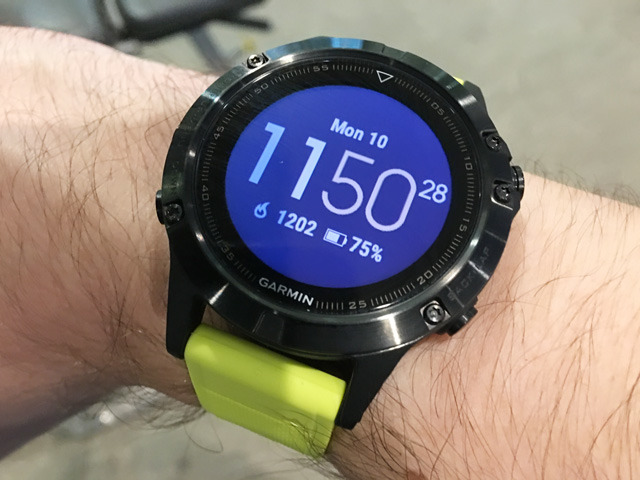
Like its predecessor, the Fenix 3 HR, the Fenix 5 doesn't mess around. While the 5 does have a faster processor and a (slightly) sharper display than the 3 HR, any apps it supports -- first- or third-party, the latter from the Connect IQ store -- are still almost exclusively fitness- or navigation-oriented. Garmin sells it as a "multisports GPS watch," and suitably, people who want to play games or control their smarthome accessories should probably look elsewhere -- even its weather, music, and notification widgets feel like luxuries.
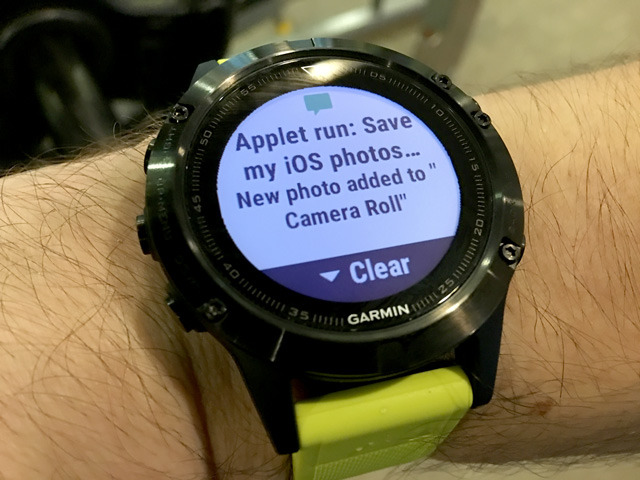
Our review unit was an upgraded version of the standard Fenix 5, with a sapphire screen and hence Wi-Fi as well -- non-sapphire models are limited to Bluetooth. Two other models are available: the 5S, which is smaller and sacrifices battery life, and the 5X, which is bigger, sapphire-only, and includes extensive mapping functions, seemingly aimed at people who spend most of their lives outdoors.
The regular Fenix 5 at least feels extremely rugged. It uses screwed-down stainless steel for the bezels and undercarriage, and should be waterproof to a depth of 100 meters. We had no problems with sweat or wearing it in the shower. The sapphire option mostly makes the screen more scratch-resistant -- something worth considering, though, for buyers who like to play rough. New quick-release bands are not only durable, but easy to swap out.
Battery life is likewise pretty tough. In theory the watch can last up to 2 weeks in normal use, or 24 hours in GPS mode -- stats which simply annihilate most competing products, especially the Apple Watch. They seem to bear out in practice too, since after a week and three extended workouts, we were only down to 69 percent charge. Realistically the Fenix 5 should be taken off long before the two-week mark for cleaning and comfort's sake.
An alternate version of GPS mode, called UltraTrac, reduces sample rate but improves battery life to 60 hours. New to the Fenix 5 in this area is the use of an internal gyroscope to smooth over position data.
In fact the device is chock full of sensors, including a three-axis compass, an altimeter, and even GLONASS as an alternative to GPS. An upgraded heart rate sensor takes readings every second of every day -- while this doesn't flood Garmin Connect or Apple's Health app with a non-stop stream of data, it should in theory improve the accuracy of the data that does sync.
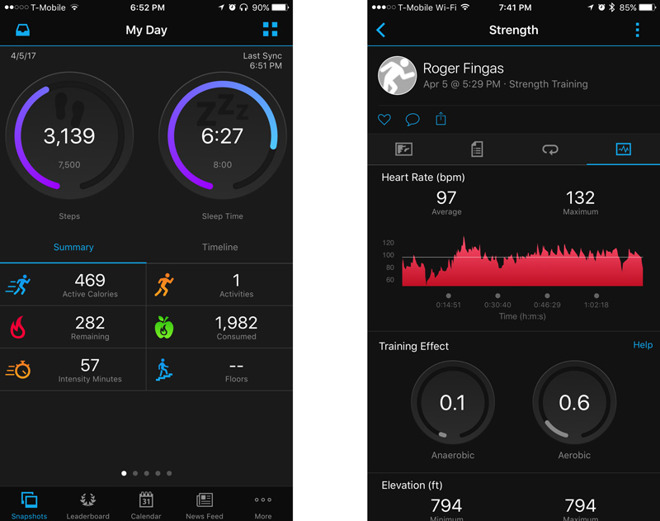
Our own testing surprised us with substantially lower heart rate numbers than some of the other fitness trackers we've reviewed, mainly in exercise. Based on various factors we suspect that the other devices were overestimating, and that Garmin's data is more accurate. True or not, we still encountered some occasional lag during workouts.
Garmin's interface design will likely remain a problem for some people, since there's no touchscreen and it can take time to memorize the button layout. To the company's credit though a faster processor does make the watch feel snappier than the 3 HR, and menus have been reorganized, making them less convoluted. It took us less time to configure the Fenix 5, including setting up a watchface with colors and complications we liked.
Inexplicably Garmin still makes users turn on gesture-triggered backlighting, something we find essential with its products. The Fenix 5's screen is always on, but like the 3 HR, it can be hard to read without direct sunlight and the backlight otherwise activates only when you hit a button.
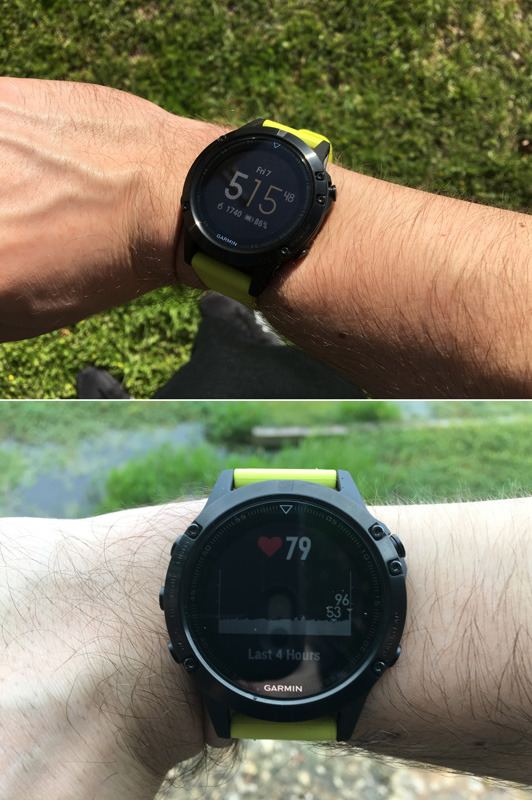
The Fenix 5 display without backlighting, in direct sunlight and cloudy skies.
For people obsessed with performance, the watch features an overwhelming number of tracking options. In addition to calorie burn, heart rate, steps, and distance, it can estimate stats like VO2 max or lactate threshold, and even gauge whether someone is improving in their training regimen over time. It also supports first- and third-party sensors like chest straps, enabling maximum accuracy in heart and running data.
It moreover offers an absurd number of pre-defined (and sometimes auto-detected) activities, including not just standard options like running and swimming but rarities like skiing and golfing. One complaint is that as usual, Garmin seems biased towards cardio workouts -- while there is a Strength activity for instance, it offers barebones data and isn't even included in the default selections.
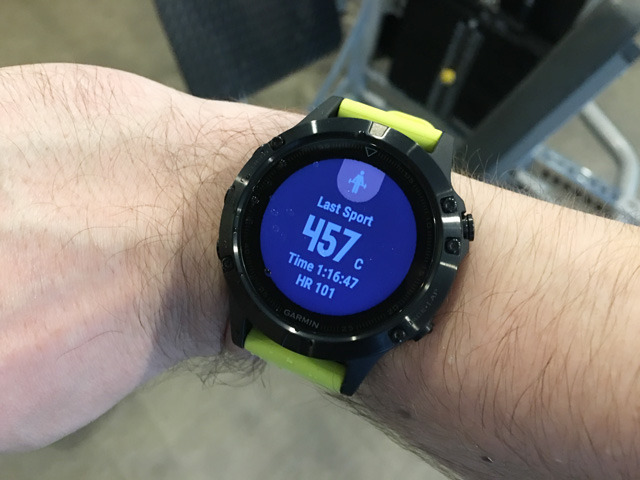
Arguably weightlifters can get the same or better by pairing a cheaper tracker with a chest strap. That being said, those who mix serious cardio into their regimens will probably enjoy the flexibility.
Even some fitness fanatics may have to wonder if they need something so extreme, however. Garmin itself sells devices which do many of the same things for less, not to mention alternatives from other "serious" fitness device makers like Polar. As we suggested, it may not make sense to get a Fenix unless cardio is a high priority.
Then of course there's the issue of life beyond gyms and trails. The watch is certainly useful for the things every smartwatch does, with the rarer bonus of that always-on display -- it's nice being able to check calories or notifications in an instant. But there are no email or password apps, no wireless payment systems like Apple Pay.
iPhone owners who need those sorts of creature comforts should probably stick with an Apple Watch Series 2. It's almost an unfair comparison though -- the Fexix 5 knows exactly where its audience lies, and for that group, there aren't many alternatives of the same caliber.

Like its predecessor, the Fenix 3 HR, the Fenix 5 doesn't mess around. While the 5 does have a faster processor and a (slightly) sharper display than the 3 HR, any apps it supports -- first- or third-party, the latter from the Connect IQ store -- are still almost exclusively fitness- or navigation-oriented. Garmin sells it as a "multisports GPS watch," and suitably, people who want to play games or control their smarthome accessories should probably look elsewhere -- even its weather, music, and notification widgets feel like luxuries.

Our review unit was an upgraded version of the standard Fenix 5, with a sapphire screen and hence Wi-Fi as well -- non-sapphire models are limited to Bluetooth. Two other models are available: the 5S, which is smaller and sacrifices battery life, and the 5X, which is bigger, sapphire-only, and includes extensive mapping functions, seemingly aimed at people who spend most of their lives outdoors.
The regular Fenix 5 at least feels extremely rugged. It uses screwed-down stainless steel for the bezels and undercarriage, and should be waterproof to a depth of 100 meters. We had no problems with sweat or wearing it in the shower. The sapphire option mostly makes the screen more scratch-resistant -- something worth considering, though, for buyers who like to play rough. New quick-release bands are not only durable, but easy to swap out.
Battery life is likewise pretty tough. In theory the watch can last up to 2 weeks in normal use, or 24 hours in GPS mode -- stats which simply annihilate most competing products, especially the Apple Watch. They seem to bear out in practice too, since after a week and three extended workouts, we were only down to 69 percent charge. Realistically the Fenix 5 should be taken off long before the two-week mark for cleaning and comfort's sake.
An alternate version of GPS mode, called UltraTrac, reduces sample rate but improves battery life to 60 hours. New to the Fenix 5 in this area is the use of an internal gyroscope to smooth over position data.
In fact the device is chock full of sensors, including a three-axis compass, an altimeter, and even GLONASS as an alternative to GPS. An upgraded heart rate sensor takes readings every second of every day -- while this doesn't flood Garmin Connect or Apple's Health app with a non-stop stream of data, it should in theory improve the accuracy of the data that does sync.

Our own testing surprised us with substantially lower heart rate numbers than some of the other fitness trackers we've reviewed, mainly in exercise. Based on various factors we suspect that the other devices were overestimating, and that Garmin's data is more accurate. True or not, we still encountered some occasional lag during workouts.
Garmin's interface design will likely remain a problem for some people, since there's no touchscreen and it can take time to memorize the button layout. To the company's credit though a faster processor does make the watch feel snappier than the 3 HR, and menus have been reorganized, making them less convoluted. It took us less time to configure the Fenix 5, including setting up a watchface with colors and complications we liked.
Inexplicably Garmin still makes users turn on gesture-triggered backlighting, something we find essential with its products. The Fenix 5's screen is always on, but like the 3 HR, it can be hard to read without direct sunlight and the backlight otherwise activates only when you hit a button.

The Fenix 5 display without backlighting, in direct sunlight and cloudy skies.
For people obsessed with performance, the watch features an overwhelming number of tracking options. In addition to calorie burn, heart rate, steps, and distance, it can estimate stats like VO2 max or lactate threshold, and even gauge whether someone is improving in their training regimen over time. It also supports first- and third-party sensors like chest straps, enabling maximum accuracy in heart and running data.
It moreover offers an absurd number of pre-defined (and sometimes auto-detected) activities, including not just standard options like running and swimming but rarities like skiing and golfing. One complaint is that as usual, Garmin seems biased towards cardio workouts -- while there is a Strength activity for instance, it offers barebones data and isn't even included in the default selections.

Arguably weightlifters can get the same or better by pairing a cheaper tracker with a chest strap. That being said, those who mix serious cardio into their regimens will probably enjoy the flexibility.
Conclusions
The Fenix 5 is a natural option for hikers, triatheletes, or just athletes in general. It's indestructible, and bound to last as long as they could possibly demand.Even some fitness fanatics may have to wonder if they need something so extreme, however. Garmin itself sells devices which do many of the same things for less, not to mention alternatives from other "serious" fitness device makers like Polar. As we suggested, it may not make sense to get a Fenix unless cardio is a high priority.
Then of course there's the issue of life beyond gyms and trails. The watch is certainly useful for the things every smartwatch does, with the rarer bonus of that always-on display -- it's nice being able to check calories or notifications in an instant. But there are no email or password apps, no wireless payment systems like Apple Pay.
iPhone owners who need those sorts of creature comforts should probably stick with an Apple Watch Series 2. It's almost an unfair comparison though -- the Fexix 5 knows exactly where its audience lies, and for that group, there aren't many alternatives of the same caliber.

Comments
One of its inherent advantages to the athlete is the Garmin's always-on screen which (combined with its easy to read typefaces) make it quicker and easier to read at a quick glance while running than that of the Apple Watch -- which not only burns battery life but has to come on and then refresh but yet remains harder to see in bright sun. That's not to trash the Apple Watch screen -- it's OLED screen has other advantages for other applications that the Garmin not only fails at but doesn't even try.
On functionality, I think Apple let themselves fall into a trap where the Apple Watch is typically compared to other watches like the Garmin as a standalone watch without its accompanying phone. The IPhone adds sensors and functional enhancements such as: additional sensors, LTE, larger memory for music, etc., a camera and so on.... Yet, it is pretty much always assumed by reviewers that a runner always leaves his phone at home while running and that the original and Series One Apple Watches are worthless for athletes and runners. But, in my experience very few runners do that -- they want the security of having that phone with them. So, for a real comparison, we should be comparing the Apple Watch with its Iphone to the standalone Garmin watch. Then we would get, in many ways, a very different story.
But, Apple has room to improve the Apple Watch -- even with its phone. It's third party fitness app vendors have yet to take full advantage of Watch OS3. Apple should support and encourage them. Also, Apple could improve its own exercise app by adding additional features such as post-run heart rate and pace graphs as well as improving display flexibility because currently it displays 5 metrics in a tiny little, hard to see font that works well while you're sitting at a desk but not while you're running. And, the only flexibility is to eliminate some of those metrics -- but it continues to use the same tiny, hard to see font.
I think Apple should bring in some serious amateur athletes and have them make recommendations on how the Apple Watch could best meet their needs - rather than rely on media reviews, desk-bound geeks, medical personnel, very casual exercisers, and Nike as the only input.
Fenix 5S: 42mm wide, for smaller wrists – available in regular glass and Sapphire glass
Fenix 5: 47mm wide, standard base model – regular glass and Sapphire glass
Fenix 5X: 51mm wide, includes mapping – only in Sapphire glass
These devices are not even good for those with health issues. Here a rapidly changing heart rate can signal a medical emergency, yet a rapidly changing HR merely confuses these devices, they're truly built for stable heart rates and everything else simply doesn't work.
As the author notes, for fitness you're best going off with a small light device and a chest strap. My recommendation is the aluminium apple watch and the bluetooth wahoo chest HR monitor, they work flawlessly together. (And the Apple Watch has the most accurate heart rate sensor for the wrist regardless.)
Also, to your latter suggestion I'm quite certain Apple already is doing this. They do not rely on web reviews to improve product.
You won't find more thorough testing, nor better advice for anyone considering a fitness tracker than he offers.
And nobody calls the Apple Watch a toy except you buddy.
This thing is ugly as sin and not meant for women in general, and men outside the times they're exercising.
http://i65.tinypic.com/2aglxjq.jpg
I did NOT say: "this is a serious competitor to the AW"
I DID say: "This is a serious competitor to the Apple Watch for serious athletes / workout fans"
Sorry, but those are two very different statements.
I agree with you that the Apple Watch is a superior generalized device. But, in reality, Apple has learned that it will not succeed that way and is strongly pushing it into the exercise/activity tracker market. Specifically: originally they marketed as a medic al device. That didn't work. Then they tried pushing it as a spiffy tech gadget and fashion trinket. That didn't work either. So, with the successors to the original series they have jumped into the middle of the Sports/Exercise monitor market.
But, as this review points out: they are not the premier player in the athletics market.
So, will the Apple Watch continue to be "A jack of all trades, master of none", or will it strive to be the best?
... Personally, I am rooting for the latter -- and I think that (with a few limitations like the OLED screen) they can do it.
1) The Fenix 5 is not just for triathletes and ultras -- it would work well for most serious runners regardless of distance.
2) I know a number of serious runners and very few of them continue to use a chest strap. They are all migrating to wrist based monitors.
As an aside:
As a curiosity, I compared my Polar H7 chest strap to the HR from my Apple Watch on both of 2 consecutive runs -- and I don't know which to believe: The heart rate from H7 was considerably higher and it bounced all over the place. Based on how I felt during the run, the HR from my Apple Watch seemed to be more correct -- and when I stopped one time and took a manual heart rate, it too jived with the watch. But, as you point out, the chest straps are typically more accurate.
... I just can't figure out how to interpret that or where to go with it.... Very weird.
I am speculating that the difference might have come from how the heart rate is processed in the algorithm: If the sample is taken every second and the actual heart rate is in the 120-150BPM range, some seconds will get 2 beats and some 3 -- so if it is reported directly, the HR will bounce around. I am thinking that the Apple Watch may smooth that out in its algorithm before reporting it.
Sorry but that's nonsense. Apple produces the finest smartphone, tablet, smartwatch, laptop, desktop, and wireless headphones I've every used. All routinely copied by their competitors. I can't imagine using anybody else's. These products have nothing to do w/ marketing and everything to do with excellent build and functionality. And, as they always have since the 1980s, they get better with every iteration.
Also, the AW's HR monitoring has been identified as the best in class on multiple occasions. Note that "in class" means for a cheap wrist device -- a chest strap will perform better, which is why the AW can pair to one as well. For a non-professional, recreational athlete, the wrist-worn HR monitoring on the AW is fine. It's not going to hold back your workouts or performance. If you need a strength-training compatible device, or more serious running device, they exist -- as specialist devices. That's a different job-to-be-done than a generalist device like the AW.
I own the Fenix 5S Sapphire (42mm) and have (very) tiny wrists. It's not bulky at all, no issue to wear it underneath long sleeves.
Looks:
It comes with a black strap as well, which you can use when wearing it at the office. The display isn't as bright and high res as e.g. the Apple Watch. But it's the right trade-off between very long battery life (critical for endurance sports) and display quality.
Rugged:
Any watch can break/scratch at some point. But it's definitely more rugged that *most* other serious sport/smart watches. And many ppl will buy a new watch in a couple of years anyway, to get the latest features. So for me it's rugged enough, more rugged only means more expensive and heavy.